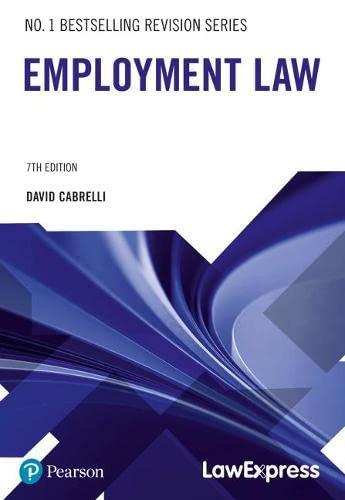Question
During World War I, the British government set up the Industrial Fatigue Research Board (IFRB), later known as the Industrial Health Research Board (IHRB) (Haight
During World War I, the British government set up the Industrial Fatigue Research Board (IFRB), later known as the Industrial Health Research Board (IHRB) (Haight 2001). The board was made due to worry for the enormous number of unintentional passings and wounds in the British conflict creation enterprises. One of the informational indexes they considered was the quantity of mishaps experienced by ladies dealing with 6-inch shells during the period February 13, 1918 to March 20, 1918. These are shown in the table that follows. Consequently, 447 ladies had no mishaps during this time-frame. in any case, 2 had in any event 5 mishaps. Number of Frequency Accidents Observed
0 447 1 132 2 42 3 4 3 5 or more a Find the normal number of mishaps a lady had during this time-frame. (Expect that all perceptions in the classification - at least 5" are actually 5.)
b After crafted by von Bortkiewicz (see Section 4.7.3), the Poisson conveyance had been applied to countless arbitrary wonders and, with few special cases, had been found to depict the information well. This had driven the Poisson appropriation to be known as the 'irregular circulation," a term that is as yet found in the writing. In this way, the mathematicians at the IFRB started by demonstrating these information utilizing the Poisson conveyance. Track down the normal number of ladies having 0, 1, 2, 3, 4, and 5 mishaps utilizing the mean found to some degree (a) and the Poisson dissemination. How well do you think this model depicts the information?
c Greenwood and Woods (1919) recommended fitting a negative binomial appropriation to these information. Track down the normal number of authorized drivers having 0,1, 2, 3, 4, and 5 mishaps utilizing the mean found partially (a) and the mathematical (negative binomial with r= 1) dissemination. How well do you think this model portrays the information? Authentic note: Researchers were perplexed regarding why the negative binomial fit better compared to the Poisson appropriation until, in 1920, Greenwood and Yule proposed the accompanying model. Assume that the likelihood any given authorized driver will have a mishap is conveyed by a Poisson dispersion with mean A. Be that as it may, A fluctuates from one lady to another as indicated by a gamma conveyance (see Chapter 5). At that point the quantity of mishaps would have a negative binomial appropriation. The worth of A related with an authorized driver was called their - mishap inclination."
Question 68
In the game Lotto 6-49, six numbers are arbitrarily picked without substitution from 1 to 49. A player who coordinates with every one of the six numbers in any request wins the big stake.
a What is the likelihood of winning any given bonanza with one game ticket? b If a game ticket costs $1.00, what are the generally anticipated rewards from playing Lotto 6-49 once. c Suppose an individual gets one Lotto 6-49 ticket every week for a very long time. Expecting all years have 52 weeks, what is the likelihood of succeeding at least one bonanza during this time? (Clue: Use a Poisson guess.) d Given the setting partially (c), what are the generally anticipated rewards more than 100 years?
Question 69
The likelihood of a client's showing up at a basic food item administration counter in any one second equivalents 0.1. Expect that clients show up in an arbitrary stream and, subsequently, that the landing in any one second is autonomous of some other appearance. Likewise accept that at most one client can show up during any one second.
a Find the likelihood that the primary appearance will happen during the third 1-second span. b Find the likelihood that the main appearance won't happen until in any event the third 1-second stretch. c Find the likelihood that no appearances will happen in the initial 5 seconds. d Find the likelihood that in any event three individuals will show up in the initial 5 seconds.
Question 70
The maker of a low-calorie dairy drink wishes to analyze the taste allure of another equation
(8) with that of the standard equation (A). Every one of four adjudicators is given three glasses in irregular request: two containing equation An and the other containing recipe 8. Each judge is approached to pick which glass he most delighted in. Assume that the two recipes are similarly alluring. Leave X alone the quantity of judges expressing an inclination for the new recipe.
a Find the likelihood work for X. b What is the likelihood that at any rate three of the four adjudicators will express an inclination for the new recipe? c Find the normal worth of X. d Find the change of X.
Step by Step Solution
There are 3 Steps involved in it
Step: 1

Get Instant Access to Expert-Tailored Solutions
See step-by-step solutions with expert insights and AI powered tools for academic success
Step: 2

Step: 3

Ace Your Homework with AI
Get the answers you need in no time with our AI-driven, step-by-step assistance
Get Started


